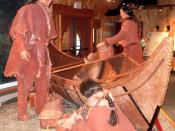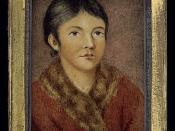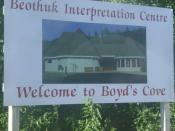Historical Background
The Beothuk people lived on the island of Newfoundland. They lived there for around 900 years. There are three main ideas as to how they arrived in the region. They could have walked across the Bering Strait from Labrador as the ice retreated. It is also possible that they canoed across the Cabot Strait from Nova Scotia. Another, newer possibility is that they descended from the Maritime Archaic Indians who lived in the area over 1000 years ago.
The Beothuk population in Newfoundland numbered in the thousands at its peak, with 60 to 80 in each tribe. When John Cabot arrived in 1497, there was only as estimated 500 Beothuks remaining. In 1822, when Shawnawdithit was captured, there was only 10-15 Beothuks remaining.
One of the unique Beothuk archaeological sites in Newfoundland is at Boyd's Cove. There were at least 11 houses, 9 circular and 2 oval in shape.
Excavation of four of these houses revealed a strange variety of artefacts. There were iron nails that they converted into arrow and spearheads. There were also stone scrapers and arrowheads. This tells us that the Beothuks, at least at this site, were in transition between the stone and iron ages. Archaeologists also discovered a large amount of bone pendants. It was originally believed that the pendants we only used in burial ceremonies but the number of pendants at the Boyd's Cove site suggests that they had other purposes. Also discovered at this site were pieces of Normandy Stoneware, pipe stem fragments and glass trade beads.
The trade beads raise many interesting questions. The other European articles found on this site, the iron nails, the stoneware, and the pipe stems could have been acquired by the Beothuks stealing from the Europeans. The trade beads, however, could only have been...


